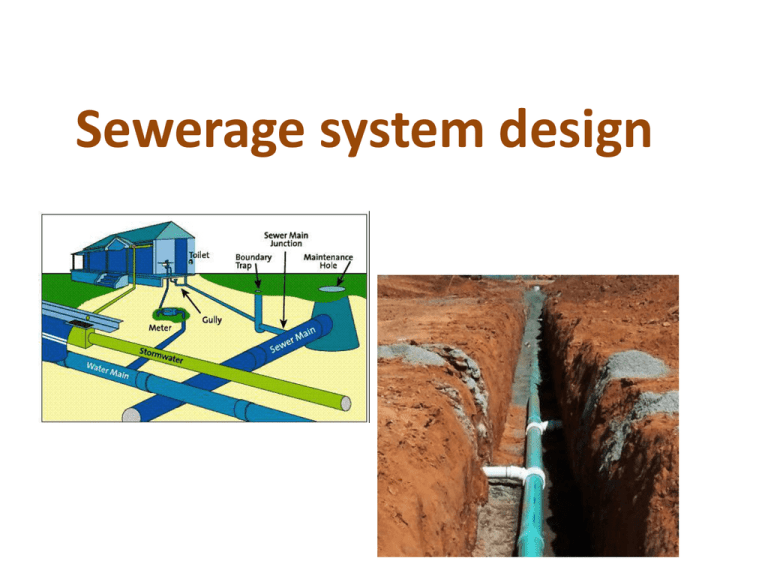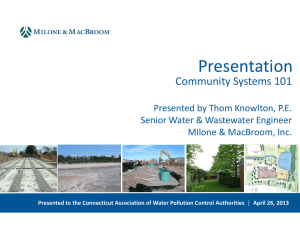Sewerage system design
advertisement

Sewerage system design • Calculation waste water flow rate based on population. • Calculate BOD5 to indicates strength and weakness of wastewater. • Design criteria of sewer system based on UK standard. • Waste water treatment process Types of sewer Foul Sewerage(Sanitary) • The main flow in a foul sewerage system is generally the polluted water-borne waste from domestic buildings, • Consider the connection from the house to the sewer, which is known as a house connection or drain. Drains • To determine wastewater flows in building drainage. • Following the guidance in BS EN 752 Drain and sewer systems outside buildings, and BS EN 12056-2 Gravity drainage systems inside buildings - Part 2: Sanitary pipework, layout and calculation. •For intermittent use a factor of 0.5 may be applied, so in a total of N dwellings, the flow is then given by Q [litres/second] = 0.5 (3N) •subject to a minimum design flow of 1.6 litres/second, and with the depth of flow d 0.7 D to allow ventilation. •Self cleansing conditions are usually ensured by simple gradient rules, such as a 100 mm pipe at a slope of 1 in 40. REFERENCES • Building Regulations Approved Document H (reprinted 2010, free to download from http://www.planningportal.gov.uk), which follows a similar approach to that described above. • Manufacturers’ organisations also publish useful information, such as the Clay Pipe Development Association (CPDA) booklet entitled The specification, design and construction of drainage and sewerage systems using vitrified clay pipes. Foul Sewers •For sewerage systems, wastewater flows are usually determined on a population basis, as described for the UK in the following sections. • Traditionally in UK, the average foul flow in a sewer is known as the dry weather flow , DWF, and may be expressed DWF = P.G + I + E P = population G = wastewater flow per person I = infiltration E = industrial effluent/sewage *The average daily domestic flow per person (G) in UK is given as ranging from 150 to 300 litres/day (BS EN 752:2008 p.97, Table E.4). Criteria for Population Equivalent (PE) Calculation (MS-1228) Foul sewer design flows by the population method •Foul sewers in UK are designed for up to 6 times of DWF (BS EN 752:2008, p.98, Table E.5). This is dependent on catchment size, and additional allowance is made for infiltration. For new housing areas in UK, the following is usually assumed: 3 people per dwelling 200 litres per person per day ( G ) 10 % infiltration ( i.e. I = 10 % of P.G, so multiply P.G by 110/100 ) 6 times peaking factor So the peak flow per dwelling := 6xDWF =6( P.G + I + E) = 6 [3 x 200 x 110/100] 4000 litres/day = 0.046 l/s This is referred to as the design flow. A lower peak of two times the average (2 DWF) is assumed to occur at least once daily (see BS EN 752:2008 p.150, NA.11.2.3.1), and is used for minimum velocity considerations, as described in the following section. Self cleansing velocities for foul sewers • BS EN 752 (2008) recommends a velocity of at least 0.7 m/s for pipes up to 300 mm diameter (p.61, 9.6.3.1), but higher velocities may be needed in larger pipes (p.150, NA.11.2.3.1). A flow of two times the average domestic flow is used for this calculation. • Sewers for Adoption (SfA) requires a velocity of 0.75 m/s at one-third of the design flow. (One third of 6DWF equals 2 DWF, which is the flow at which velocity should be checked). • Where this velocity requirement cannot be met, then the self cleansing criterion would be considered to be satisfied if one of the following gradient rules applies: • a 150 mm nominal internal diameter gravity sewer having a gradient not flatter than 1 in 150 where there are at least ten dwelling units connected. • a sewer or lateral drain with a nominal internal diameter of 100mm, or a lateral drain serving ten or less properties, laid to a gradient not flatter than 1:80 where there is at least one WC connected, or 1:40 if there is no WC connected. Pipe roughness • The typical roughness value used for foul gravity sewer design is ks = 1.5 mm, for any pipe material. • In time, pipes slime up and give a similar roughness, regardless of their material. From experimental work on clay and pvc pipes reproduced in CPDA (2001) Other practical design criteria for foul sewerage • The minimum pipe diameter for foul sewers in the UK was traditionally 150 mm, but now 100 mm is allowed for ten properties or less. 100 mm is the traditional size for individual house connections. • Manholes are required at changes in size, slope or direction; • The maximum spacing is 100m, although this may be increased for man entry sizes (greater than 900 mm diameter), but is often less than this to accommodate branches and bends. • At manholes where pipe sizes change it is usual to align the levels of the pipe soffits(highest point of internal surface). • Slopes to be considered in design are: the natural ground slope, the required self cleansing gradient, the slope to achieve or maintain minimum cover. • A useful approximate rule is that a D (mm) diameter sewer laid at a slope of 1 in D will give a velocity approximately equal to the self cleansing value. This gradient rule is mentioned in BS EN 752:2008 p.61, 9.6.3.1. e.g. 225 mm sewer with roughness k = 1.5 mm laid at 1 in 225 gives a pipe full flow of 30 litres/s and pipe full velocity of 0.75 m/s. • A pumping station may be needed to lift foul flows from a new development into the existing sewer system, but is best avoided if possible. Waste water treatment Waste water treatment •Processes that combine physical, chemical and biological methods. •Wastewater treatment plants are usually classified as providing primary, secondary or tertiary (or advanced) treatment, depending on the purification level to which they treat. *BOD5 = amount of organic pollution (that can be oxidized biologically) in a sample of water. CHEMICAL CHARACTERISTIC •Alkalinity: an indicator of wastewater’s capacity to neutralize acids, alkalinity is measured in terms of bicarbonate, carbonate and hydroxide alkalinity. Alkalinity is essential to hold the neutral pH of the wastewater during biological treatment. •Biochemical oxygen demand (BOD): an indicator of the amount of biodegradable matter in the wastewater, normally BOD is measured in a 5-day test conducted at 20°C (BOD5) and normally ranges from 100 to 300mg/L •Chemical oxygen demand (COD): an indication of the amount of oxidizable matter present in the sample, the COD is normally in the range of 200 to 500 mg/L. Industrial wastes present in the wastewater can significantly increase this. •Dissolved gasses: the specific gases and normal concentration dissolved in wastewater are based on wastewater composition, and under septic conditions may typically include oxygen in relatively low concentration, carbon dioxide, and hydrogen sulfide. •Nitrogen compounds: nitrogen’s type and amount vary from raw wastewater to treated effluent, but nitrogen oxygen is mostly found in untreated wastewater in the forms of organic nitrogen and ammonia nitrogen (presence and levels determined by laboratory testing). •Total Kjeldahl nitrogen (TKN): the sum of these forms of nitrogen. Normal wastewater contains 8 to 35 mg/L and ammonia nitrogen ranging from 12 to 50 mg/L. •pH: pH express wastewater’s acid condition. For proper treatment, wastewater pH should generally range from 6.5 to 9.0. •Phosphorus: •in secondary treatment process, phosphorus must be present in at least minimum quantities or the process won’t process. •However, excessive phosphorus causes stream damage and excessive algal growth. •Phosphorus normally range 6 to 20 mg/L. •Solids: •most wastewater pollutants can be classified as solids, and wastewater treatment is generally designed to either remove solids, or convert them to more stable or removable forms. • General practice classifies solids as setteleable, floatable, or collodial. •Total solids concentration in wastewater normally ranges from 350 to 1,200 mg/L. Diagram of sewage treatment process cycle •Remove 90-95% settleable solids 4060% total suspended solids, and 25 to 35% BOD •Removes gravel, sand, silt and other gritty materials •Reduces odors, neutralizes acids, reduces corrosion,reduces BOD5, improves solids and grease removal, reduces loading on the plant and aids subsequent processes. Produces effluent/sewage with not more than 20 mg/L BOD5 and 30 mg/L suspended solids Removes pollutants, including nitrogen, phosphorus, soluble COD and heavy metals to meet discharges or reuse criteria with respect to specific parameters Example of calculating average daily wastewater flow rate Question: Table shows the information of daily wastewater flow rate and BOD5 concentration for an urban area. Determine the average daily wastewater flow rate and BOD5 concentration. Utility Domestic Hospital Restaurant School with cafe School without cafe BOD5 (kg/day) per capital per capital per capital Average Flowrate (l/day) 625 600 30 1500 students each per student 280 0.1 5400 student each per student 60 0.03 Population Equivalent (PE) Unit 30 000 650 bed 250 customers per day 0.1 0.15 0.03 Solution i. Calculate the average wastewater flow rate Utility PE x average daily flowrate Domestic Hospital Restaurant School with cafe School without cafe Total wastewater flow 30 000 x 625 650 x 600 250 x 30 1500 x 280 18,750,000 390,000 7500 420,000 5400 x 60 324,000 19,891,500 (litre/day) ii. Calculate the average BOD5 concentration Utility Population Equivalent (PE) BOD5 (kg/day) PE x BOD5 Domestic 30 000 0.1 30000x0.1 3000 Hospital 650 bed 0.15 650x0.15 97.5 0.03 250x0.03 7.5 0.1 1500x0.1 150 0.03 5400x0.03 162 Restaurant School with cafe School without cafe 250 customers per day 1500 students each 5400 student each 3417 kg/day Total BOD5 Average BOD5 concentration =Total BOD5 /Total wastewater flow rate Convert unit to mg/L 3417 19,891,500 =0.000172 Kg/day Liter/day











